Grow Your Own Display for the Lunar New Year
Symbolism plays an important role during the Lunar New Year. Everything associated with the festivities have auspicious- sounding names, even plants. Festive plants and flowers with auspicious names are bought potted or in stalks at their prime from nurseries and used to decorate the house.
If you want to have something different this year, why not try your hands at growing your own display plants?
With less than a month to go, hurry to the market now to buy three vegetables that you can grow into lucky display plants: Chinese arrowhead (Sagittaria sagittifolia); Chinese water chestnut (Eleocharis dulcis); and the cocoyam (Colocasia esculenta).
The supply of the Chinese arrowhead is seasonal and appears in the market only for a short period prior to the Lunar New Year. The latter two vegetables are sold all year round.
The symbolism behind the plants' names:
The Chinese arrowhead (慈菇; cí gū), due to its Chinese name, implies benevolence. Its arrowhead-shaped leaves that grow skywards signify continuous improvement and progress in all endeavours in the New Year.
The Chinese water chestnut (荸薺; bíqí) symbolises unity, a value that the Chinese holds dear for the family.
The cocoyam (芋头, yùtou) has the same pronunciation as 预头 which means 'luck' in Mandarin.
Learn about plant parts!
Did you know these three vegetables are plant parts that are botanically classified as corms? You can have your kids learn more about their food by observing closely the exterior appearances of these vegetables and also through cross-sections to view the interior structure.
Corms are compressed underground stems that also serve as specialised food storage organs. They contain dormant buds on the exterior which can become new growth. Although they look somewhat like onions (true bulbs), corms are solid tissue when cut across, which is unlike the layered fleshy scales of the onion that are actually modified leaves. They are also not tubers. Common underground vegetables like the potato are stem tubers, whereas the sweet potato is a root tuber. A stem tuber may be distinguished from a root tuber by the presence of buds or 'eyes' on its exterior.
Choosing planting materials
Similar to buying ingredients for cooking, the corms selected for planting should not show signs of damage or disease.
Preferably, there should be growing points already present which can give you a faster headstart compared to those with their growing points damaged or cut-off by the seller.
Planting them...
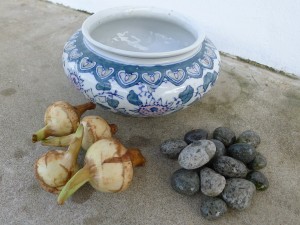
For the container, choose one that you would want to display them in for the festivities.
When growing the Chinese arrowhead and Chinese water chestnut, you can plant them inside a water-tight container using large smooth pebbles as the growing substrate. For the cocoyam, you can use commercial potting soil placed inside a container with drainage holes at the base.
Follow the steps given below:
Step 1: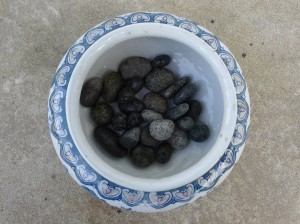
Fill the bottom of the container with the recommended substrate.
Step 2: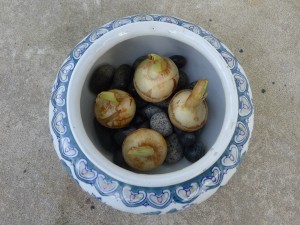
Place the corms on the soil surface and space them out adequately, say, a distance of about at least 5 cm should be given between neighbouring corms.
Step 3:
Fill the gaps with soil, taking note not to bury the growing point . The soil surface should ideally be level with the base of the growing point. Finally, water thoroughly to settle the substrate. Ensure the corms are seated securely in the container.
Step 4: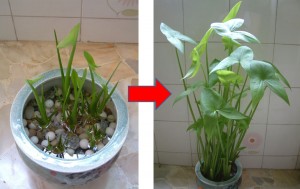 Watch your corms put forth new growth! Place the container in a sunny location of your home, for example, at the balcony or corridor. Plants should be given at least 6 hours of direct sunlight daily to ensure healthy growth.
Watch your corms put forth new growth! Place the container in a sunny location of your home, for example, at the balcony or corridor. Plants should be given at least 6 hours of direct sunlight daily to ensure healthy growth.
Step 5: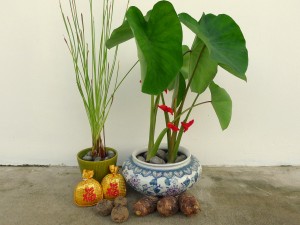
As the plants grow, you can decorate them by tying red ribbons around them or even put in a layer of golden-coloured pebbles on the soil surface. Let your creative juices flow! Shown here are Chinese water chestnut and cocoyam plants.
Interestingly, all three vegetables are plants, which in their native habitats, grow in exposed wet and marshy areas. Keeping this in mind, these plants should be given lots of sun and the soil of these three vegetables should be kept moist at all times and not allowed to dry out totally.
By Wilson Wong
Photo for Step 4 by Mr Tan Boon Kiat.



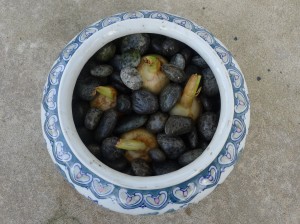


Have views or comments on this article? Let us know via this form. If you would like to give us feedback on any other areas relating to our parks and gardens, please submit via https://www.nparks.gov.sg/feedback